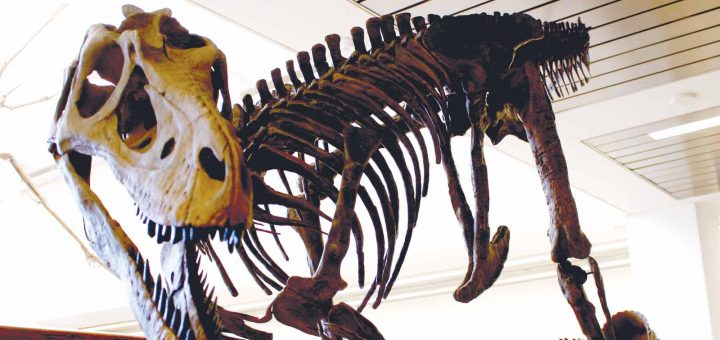Walking with dinosaurs

New exhibit showcases creatures from the Cretaceous Period
By Anna Junker, News Editor
Mount Royal University unveiled a new prehistoric fossil exhibit on Jan. 11. for students and members of the public to enjoy for free.
Installed in the atrium and the ceilings of Mount Royal’s East Gate and B Wing, the new exhibit, titled Cretaceous Lands, joins the university’s already established and popular Cretaceous Seas.
The new exhibit features life-sized casts of the skeletons of two dinosaurs and one marsupial, animals which roamed the planet over 65 million years go.
The Cretaceous Period occurred 144 to 65 million years ago and ended about 64 million years before the first humans evolved.
During the mid to late Cretaceous, much of Alberta was covered by marine waters. In the mild to cool water temperatures, predatory marine life flourished. Nearly complete skeletons of reptiles including mosasaurs, plesiosaurs and ichthyosaurs have been found in southern Alberta and near Fort McMurray.
The Cretaceous Period also saw the rise of the mountain range along the western end of North America. This created river systems which brought vast quantities of sediment eastward into Alberta. There it accumulated in thick layers which are now exposed by erosion in the valleys and badlands throughout the province. The area was swampy, subtropical with coastal lowlands which supported forests of conifers, cycads, ginkgoes and early flowering plants. The vegetation served diverse plant-eating dinosaurs, which in turn were prey for predators.
The three new creatures displayed in front of the Pteranodon, which has been suspended in flight for a few years now near the Iniskim Centre include Nanotyrannus lancensis, Triceratops horridus and Didelphodon vorax.
Nanotyrannus lancensis was thought to be a juvenile Tyrannosaurus rex. However, the skull bones are fused, suggesting it is an adult and it has more teeth in its jaws than a T. rex does. Although, this could just simply reflect change during growth or variation of individuals within a population. It was an agile predator with dagger-like teeth, a sleek skeleton and may have hunted in packs.
Triceratops horridus was a large, four-legged plant eater that weighed up to 12 tonnes, about twice the weight of an African bush elephant. The baby that’s displayed in Cretaceous Lands is thought to be between one and three years old. Triceratops was among the last of the dinosaurs before mass extinction brought an end to their reign.
Didelphodon vorax was an early member of the marsupial family. However, it was relatively large for the period it lived during, where most mammals were between mouse to cat-sized. It was a pouched mammal, related to the opossum but was semi-aquatic like an otter and may have lived in burrows in riverbanks. It had short, heavily constructed jaws and blunt premolar teeth thought to crush small pray such as lizards, frogs and the shells of mollusks.
The exhibit was made possible through donations from the Government of Alberta, Michelle O’Reilly Foundation, Alberta Palaeontological Society, Canadian Geological Foundation, Tanya and Brad Zumwalt and Professor Emeritus Wayne Haglund.




